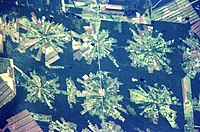
Photo from wikipedia
Market-like mechanisms for biodiversity offsetting have emerged globally as supposedly cost-effective approaches for mitigating the impacts of development. In reality, offset buyers have commonly found that required credits are scarce… Click to show full abstract
Market-like mechanisms for biodiversity offsetting have emerged globally as supposedly cost-effective approaches for mitigating the impacts of development. In reality, offset buyers have commonly found that required credits are scarce and/or expensive. One response has been to seek improved market functionality, increasing eligible offset supply by allowing greater flexibility in the offset trading rules. These include increasing the size of geographical trading areas and expanding out-of-kind trades (‘geographical’ and ‘ecological’ flexibility). We summarise the arguments for and against flexibility, ultimately arguing that increasing flexibility undermines the achievement of No Net Loss (or Net Gain) of biodiversity where high-quality governance is lacking. We argue expanding out-of-kind trading often increases the pool of potentially eligible offsets with limited conservation justification. This interferes with vital information regarding the scarcity of the impacted biodiversity feature, thereby disincentivising impact avoidance. When a biodiversity feature under threat of development is scarce, expensive offsets are an essential feature of the economics of offsetting which communicate that scarcity, not a problem to be regulated away. We present examples where increasing ecological flexibility may be justifying the loss of conservation priorities. We also discuss how increasing geographical flexibility might compromise the additionality principle. We highlight alternative mechanisms for enhancing offset supply without the risks associated with increasing flexibility, including reducing policy uncertainty and improving engagement and awareness to increase landholder participation. Although there are legitimate reasons for increasing offsetting flexibility in some specific contexts, we argue that the biodiversity risks are considerable, and potentially undermine ‘no net loss’ outcomes.
Journal Title: Biological Conservation
Year Published: 2020
Link to full text (if available)
Share on Social Media: Sign Up to like & get
recommendations!